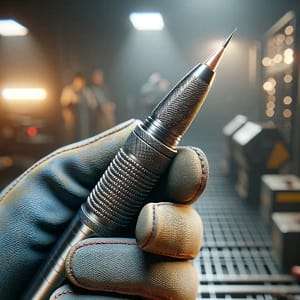Introduction:
In the metalworking and manufacturing industry, innovation and precision are key. With more than two decades of experience, our specialization in advanced techniques such as tip welding demonstrates a commitment to artistry and quality.
In this article, we will delve into tip soldering: how it works, applications, advantages, disadvantages, and strategies to overcome common challenges. If you have questions or need advice, click the contact button for personalized support. Discover more about tip welding with us!
What is Tip Welding?
Tip welding is a metal joining process that uses pressure and heat generated by electrical current without melting the base material. Using two electrodes, pressure and current are applied to metal parts, creating spot joints in specific areas. This method is ideal for joining thin sheets of metal and is widely used in industries such as automotive and electronics for its ability to produce robust and precise joints.
How does tip soldering work?
In tip welding, pieces of metal are placed between two copper electrodes that conduct high electrical currents. When current is applied, the contact points of metals are heated to a plastic state, without melting. The pressure of the electrodes joins the metals at specific points. Precisely controlling current and pressure is crucial to ensure the quality and consistency of each weld spot, being vital in applications where structural integrity and aesthetics are critical.
Tip Welding Applications
Tip welding is an essential welding technique in many industrial fields, known for its precision and efficiency. Its application ranges from automobile manufacturing to the production of electronic devices, demonstrating its versatility and reliability. Below are some of the most notable applications of tip welding:
- Automotive industry: Used to join structural components such as door panels, roofs and chassis, it provides strong, durable joints that are essential for the safety and durability of the vehicle.
- Electronics and Appliances: Essential for assembling small metal components into circuits and mobile devices, ensuring reliable and precise connections necessary for optimal operation of the devices.
- Construction of Light Metal Structures: Ideal for joining light elements in metal constructions, maintaining structural integrity without adding excessive weight.
- Aerospace industry: Applied in the manufacturing of critical aircraft components, where each weld must meet high quality and safety standards to withstand extreme conditions.
- Railway and Public Transport Sector: Used in the construction of trains and other public transport vehicles, it provides safe and durable joints that withstand intensive and continuous use.
This framework highlights how cutting edge welding drives innovation and development in a variety of fields, offering effective solutions for high precision and strength requirements.
Advantages of Tip Welding
Some of the notable advantages of this type of welding are the following:
- Efficiency and Speed: This technique stands out in its ability to make quick and efficient joints, ideal for mass production lines in the automotive industry and in the manufacture of household appliances.
- Precision and Control: Offers exact control over the location and size of welds, ensuring consistent, high-quality joints, key in applications where precision is essential.
- Low Impact on the Base Material: Minimizes alteration of the base material by concentrating heat only at specific points, preserving the integrity of the material.
- Automation: Its adaptability for automation allows for high and consistent repeatability, reducing human errors and increasing production efficiency.
These points underline the usefulness of tip welding in various industrial contexts, highlighting its contribution to faster and higher quality processes.
Disadvantages of Tip Welding
This type of welding also brings with it a series of limitations and impediments, some of the most significant are:
- Material and Thickness Limitations: Restricted to certain metals and not suitable for thick materials, this technique may be insufficient on projects requiring the welding of heavy metals or specific types that do not respond well to this method.
- High Energy Consumption: The process consumes a significant amount of energy to generate the necessary heat, raising operating costs and negatively affecting environmental sustainability.
- Risk of Deformation and Damage: Although the thermal impact on the base material is low, the intense and localized heat can cause deformations or structural damage if not managed precisely, requiring rigorous control of the process.
- Limitations on Penetration Depth: Ideal for shallow joints, but with limited depth of penetration, which can be problematic in applications that require welds that are deeper or completely through the material.
This version more clearly details the technical and practical limitations, highlighting areas where tip soldering may not be the most suitable option.
Solving Common Problems in Tip Soldering
Tip welding is a technical process that, although efficient, can face certain challenges. Identifying and resolving these issues is crucial to maintaining weld quality and effectiveness. Below are some solutions to common problems in this type of welding:
Adhesion and Weld Quality Problems
Common Cause: Often, weld quality problems are due to improper current or pressure settings, or contamination of material surfaces.
Solution: Make sure the surfaces to be soldered are clean and free of oxides or coatings. Additionally, review and adjust current and pressure parameters based on material type and thickness.
Electrode Wear in Tip Welding
Common Cause: The electrodes can wear out with use, which affects the consistency and quality of this type of welding.
Solution: Perform regular maintenance on the electrodes, replacing or reconditioning them when necessary. The use of high quality electrodes and correct machine settings can extend the life of the electrodes.
Excessive Heating and Deformations
Common Cause: Excess heat during tip welding can cause warping of materials, especially thin metals.
Solution: Control the amount of heat applied by adjusting the duration and intensity of the current. Using cooling techniques and welding in a staggered pattern can also help reduce heat buildup.
Inconsistencies in Tip Welding Over Time
Common Cause: Over time, changes in the welding machine or materials can lead to inconsistencies.
Solution: Performing periodic calibration and maintenance of your welding machine can help maintain consistent quality. Also, make sure that the materials used are consistent in terms of quality and specifications.
Safety Issues in Tip Welding
Common Cause: Lack of proper safety measures can lead to accidents.
Solution: Implements strict safety protocols, including the use of personal protective equipment and proper training of operators in safe tip welding practices.
Solving these common problems not only improves the quality and efficiency of the process, but also ensures the safety and longevity of the equipment and worked parts.
Discover Our Services
In addition to our experience in tip solder, we specialize in offering welding services High quality stainless steel. We understand the importance of precision, durability and aesthetics in every project, and our team highly trained team is ready to provide welding solutions that meet your specific needs.
We invite you to contact our expert advisors to guide you on this journey and guarantee the success of your welding projects.



